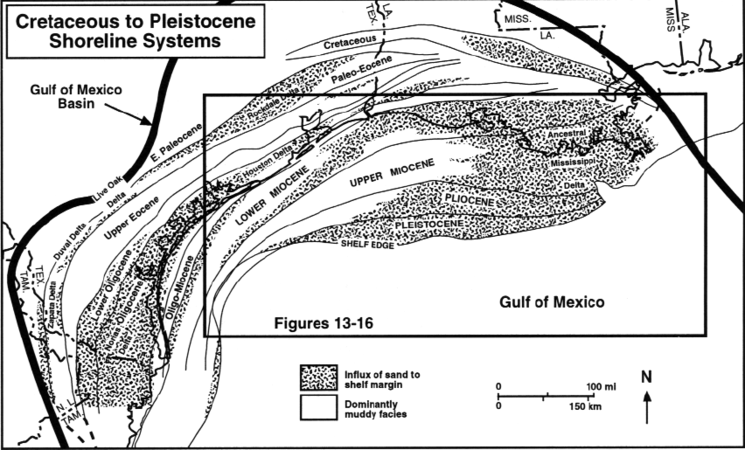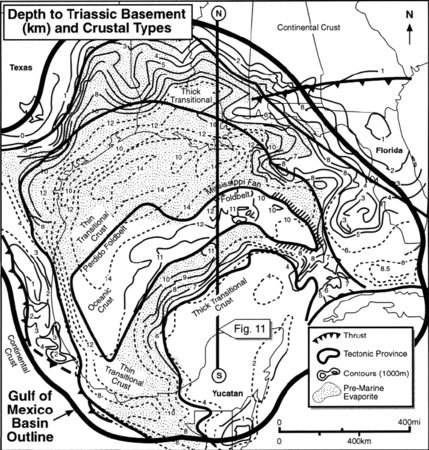Difference between revisions of "Fluvial input through time: Gulf of Mexico example"
FWhitehurst (talk | contribs) m (FWhitehurst moved page Example: mapping fluvial input to Fluvial input through time: Gulf of Mexico example: most important term first, plus was inaccurate) |
Cwhitehurst (talk | contribs) m (added Category:Treatise Handbook 3 using HotCat) |
||
| (5 intermediate revisions by 2 users not shown) | |||
| Line 6: | Line 6: | ||
| part = Critical elements of the petroleum system | | part = Critical elements of the petroleum system | ||
| chapter = Sedimentary basin analysis | | chapter = Sedimentary basin analysis | ||
| − | | frompg = 4- | + | | frompg = 4-25 |
| − | | topg = 4- | + | | topg = 4-25 |
| author = John M. Armentrout | | author = John M. Armentrout | ||
| link = http://archives.datapages.com/data/specpubs/beaumont/ch04/ch04.htm | | link = http://archives.datapages.com/data/specpubs/beaumont/ch04/ch04.htm | ||
| Line 14: | Line 14: | ||
| isbn = 0-89181-602-X | | isbn = 0-89181-602-X | ||
}} | }} | ||
| − | The [[Late Cretaceous]] to [[Holocene]] depositional history of the northern Gulf of Mexico (GOM) continental margin has been influenced by several factors:<ref name=ch04r26>Coleman, J. | + | The [[Late Cretaceous]] to [[Holocene]] depositional history of the northern [[Gulf of Mexico]] (GOM) [[continental margin]] has been influenced by several factors:<ref name=ch04r26>Coleman, J. M., and H. H. Roberts, 1991, Mississippi River depositional system: model for the Gulf Coast Tertiary, in D. Goldthwaite, ed., An Introduction to Central Gulf Coast Geology: New Orleans Geological Society, p. 99–121.</ref> |
* [[Fluvial supply system]] and [[delta]] formation | * [[Fluvial supply system]] and [[delta]] formation | ||
| Line 23: | Line 23: | ||
==Summary of GOM fluvial history== | ==Summary of GOM fluvial history== | ||
<gallery mode=packed heights=300px widths=300px> | <gallery mode=packed heights=300px widths=300px> | ||
| − | sedimentary-basin-analysis_fig4-4.png|{{figure number|1}}Major sand influxes into the northern Gulf of Mexico from | + | sedimentary-basin-analysis_fig4-4.png|{{figure number|1}}Major sand influxes into the northern Gulf of Mexico from Late Cretaceous to Holocene. After Winker;<ref name=Winker1982>Winker, C. D., 1982, Cenozoic shelf margins, northwestern Gulf of Mexico: Gulf Coast Assoc. of Geological Societies Transactions, vol. 32, p. 427-448.</ref> courtesy Gulf Coast Association of Geological Societies. |
sedimentary-basin-analysis_fig4-6.png|{{figure number|2}}Tectonic map of the GOM basin. Modified from Buffler;<ref name=Buffler1991>Buffler, R. T., 1991, Early evolution of the Gulf of Mexico basin, in D. Goldthwaite, ed., An introduction to central Gulf Coast geology: New Orleans Gulf Coast Geological Society, p. 1-16.</ref> courtesy New Orleans Geological Society. | sedimentary-basin-analysis_fig4-6.png|{{figure number|2}}Tectonic map of the GOM basin. Modified from Buffler;<ref name=Buffler1991>Buffler, R. T., 1991, Early evolution of the Gulf of Mexico basin, in D. Goldthwaite, ed., An introduction to central Gulf Coast geology: New Orleans Gulf Coast Geological Society, p. 1-16.</ref> courtesy New Orleans Geological Society. | ||
</gallery> | </gallery> | ||
| − | [[Mesozoic]] and [[Cenozoic]] fluvial systems have filled in the northern margins of the GOM [[rift]] basin, [[ | + | [[Mesozoic]] and [[Cenozoic]] fluvial systems have filled in the northern margins of the GOM [[rift]] basin, [[Depocenter#Sediment_supply_rate_and_facies_patterns|prograding]] the [[continental margin]] of one area until sediment input shifts to another area ([[:file:sedimentary-basin-analysis_fig4-4.png|Figure 1]]). [[Subsidence]] is related to [[basement]] cooling or differential response of basement types to loading ([[:file:sedimentary-basin-analysis_fig4-6.png|Figure 2]]). Formation of [[diapir]]s and tectonic movement of [[growth-fault]] systems has already being discussed as it relates to sediment loading. Fluctuation in sea level is discussed in [[Sea level cycle phase]]. |
==See also== | ==See also== | ||
| Line 43: | Line 43: | ||
[[Category:Critical elements of the petroleum system]] | [[Category:Critical elements of the petroleum system]] | ||
[[Category:Sedimentary basin analysis]] | [[Category:Sedimentary basin analysis]] | ||
| + | [[Category:Treatise Handbook 3]] | ||
Latest revision as of 17:03, 22 February 2022
| Exploring for Oil and Gas Traps | |

| |
| Series | Treatise in Petroleum Geology |
|---|---|
| Part | Critical elements of the petroleum system |
| Chapter | Sedimentary basin analysis |
| Author | John M. Armentrout |
| Link | Web page |
| Store | AAPG Store |
The Late Cretaceous to Holocene depositional history of the northern Gulf of Mexico (GOM) continental margin has been influenced by several factors:[1]
- Fluvial supply system and delta formation
- Subsidence
- Diapiric and tectonic movement
- Fluctuation in sea level
Summary of GOM fluvial history
Figure 1 Major sand influxes into the northern Gulf of Mexico from Late Cretaceous to Holocene. After Winker;[2] courtesy Gulf Coast Association of Geological Societies.
Figure 2 Tectonic map of the GOM basin. Modified from Buffler;[3] courtesy New Orleans Geological Society.
Mesozoic and Cenozoic fluvial systems have filled in the northern margins of the GOM rift basin, prograding the continental margin of one area until sediment input shifts to another area (Figure 1). Subsidence is related to basement cooling or differential response of basement types to loading (Figure 2). Formation of diapirs and tectonic movement of growth-fault systems has already being discussed as it relates to sediment loading. Fluctuation in sea level is discussed in Sea level cycle phase.
See also
References
- ↑ Coleman, J. M., and H. H. Roberts, 1991, Mississippi River depositional system: model for the Gulf Coast Tertiary, in D. Goldthwaite, ed., An Introduction to Central Gulf Coast Geology: New Orleans Geological Society, p. 99–121.
- ↑ Winker, C. D., 1982, Cenozoic shelf margins, northwestern Gulf of Mexico: Gulf Coast Assoc. of Geological Societies Transactions, vol. 32, p. 427-448.
- ↑ Buffler, R. T., 1991, Early evolution of the Gulf of Mexico basin, in D. Goldthwaite, ed., An introduction to central Gulf Coast geology: New Orleans Gulf Coast Geological Society, p. 1-16.

